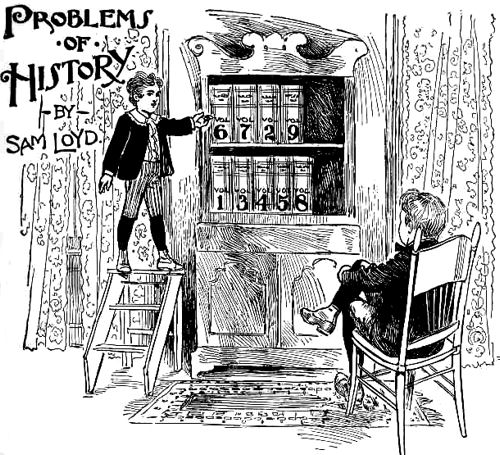



IN ACCORDANCE with the time honored belief that mathematics and history are the most important branches of education, in my early days I was presented with nine ponderous volumes of Hume's History of England, accompanied by promises galore of guns, ponies, and everything else calculated to excite a boy’s energy if I would only study those books.
Our puzzlists would not be interested in putting me through an examination of ancient history, as they would find that what I don’t know on that subject would more than double the size of an ordinary library, but some of the things which I did discover about those ponderous tomes may be worth mentioning as the subject of an interesting and instructive puzzle.
In experimenting for instance, it was found that by placing the four volumes above the eight, as shown in the picture, 6729 over 13458 is equal to one-half. Then by another mix-up of the books, always employing them all, they maybe made to represent the equivalents of one-third, one-fourth, one fifth, one sixth, one-seventh, one-eighth, and one-ninth. It is a simple puzzle, without any mathematical difficulties, so it is presented as an amusing study which will familiarize the young folks with the peculiar properties of figures.
This problem suggests an inexhaustible field of puzzles and an excellent school for learning to originate new puzzles, as the idea can be carried on indefinitely in the construction of other and more difficult problems.
To that curious study of the nine ponderous volumes of Hume's History of England which were to be arranged upon the two shelves so that the two rows of figures might be made to represent fractions equivalent to one-half, or one-third, one-fourth, one-fifth, one-sixth, one-seventh, one-eighth or one-ninth, the following clever arrangements have been received as fulfilling the conditions:
6729 1 5832 1 4392 1
----- = - ----- = - = ----- = -,
13458 2 17496 3 17568 4
2769 1 2943 1 2394 1
----- = - ----- = - = ----- = -,
13845 5 17658 6 16758 7
3187 1 6381 1
----- = - and ----- = -.
25496 8 57429 9
Of course, some of the numbers can be slightly varied and yet give the same results.
2.
What are the embers of the expiring year? November and December.
How is a poultry dealer compelled to earn his living? By foul means.
Why is a butcher's cart like his top boots? Because he carries his calves there.
Why does a maltese cat rest better in summer than in winter? Be cause summer brings the caterpillar (cat-a-pillow).
Is there anything a man with a Kodak cannot take? Yes, a hint.
Why do American soldiers never run away? They belong to a standing army.
Why does tying a slow horse to a post improve his pace? It makes him fast.
What is it that a man, no matter how smart he is, overlooks? His own nose.
What goes most against a farmer's grain? His reaper.
Why may we suppose that Noah had beer in the ark? Because the kangaroo went in with hops, and the bear was always bruin.
A duck before two ducks, a duck behind two ducks, and a duck between two ducks; how many ducks were therein all? Three in line.
How many fathers has a man? Nine: his father, his godfather, his father-in-law, his two grandfathers, and his fore- (four) fathers,
[Page 99]